Capstone Project: Technological Changes and Student Outcomes - COMP640
VerifiedAdded on 2022/09/09
|22
|15254
|25
Project
AI Summary
This project, submitted for COMP640 at the University of the Potomac, investigates the multifaceted impact of technology on students. It begins by highlighting the problem of technology overuse and its increasing dependency in modern life, referencing studies that explore how technology is used to improve surroundings and learning. The research delves into the effects of technology, particularly in classroom settings, and examines the role of various technologies. The project includes a literature review, methodology, findings, and conclusions, and it addresses the impact of technology on student learning and performance. It also explores the use of technologies like AI in education. The project aims to determine how technology is affecting students' learning and academic performance.
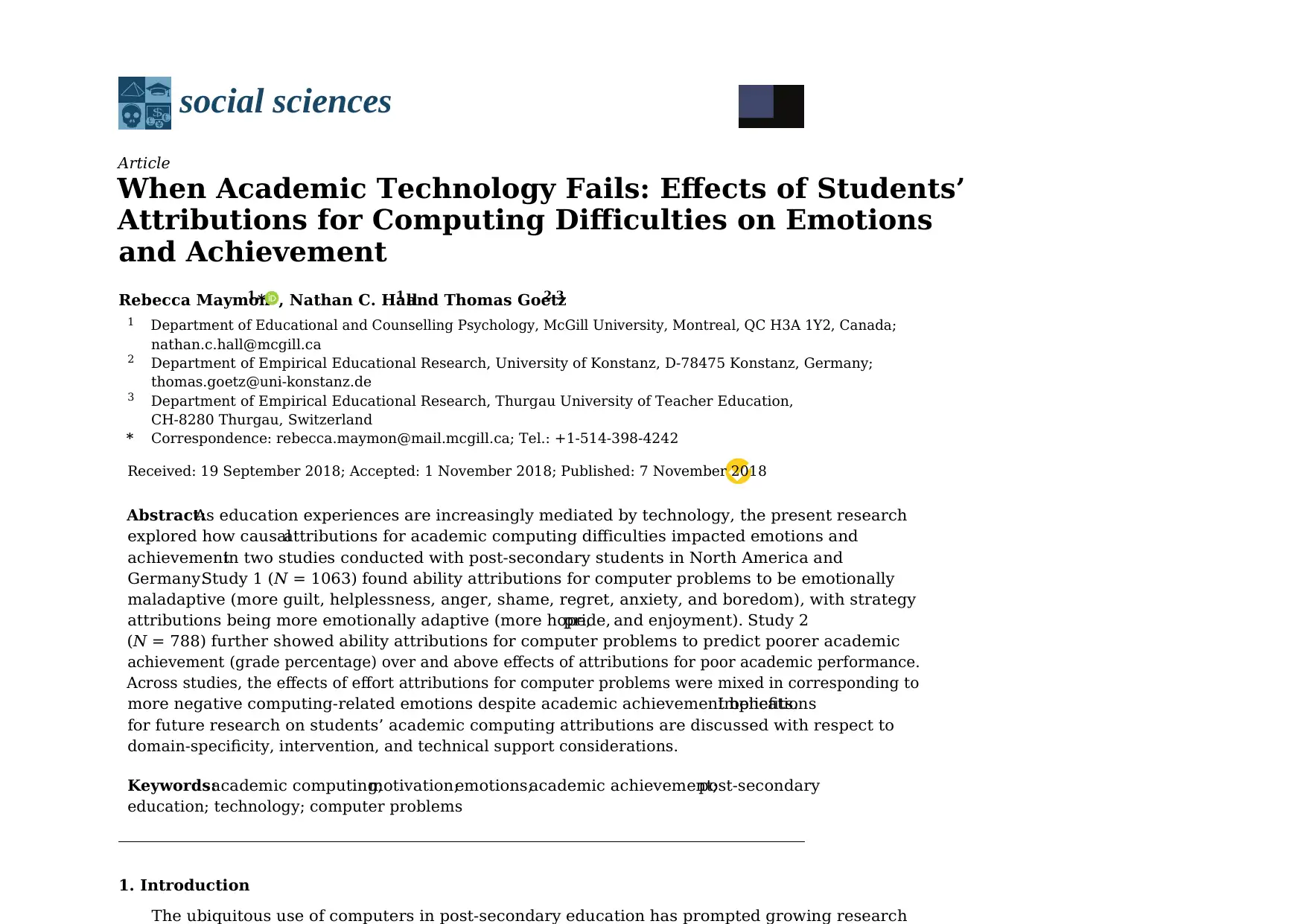
$€£ ¥
social sciences
Article
When Academic Technology Fails: Effects of Students’
Attributions for Computing Difficulties on Emotions
and Achievement
Rebecca Maymon1,* , Nathan C. Hall1 and Thomas Goetz2,3
1 Department of Educational and Counselling Psychology, McGill University, Montreal, QC H3A 1Y2, Canada;
nathan.c.hall@mcgill.ca
2 Department of Empirical Educational Research, University of Konstanz, D-78475 Konstanz, Germany;
thomas.goetz@uni-konstanz.de
3 Department of Empirical Educational Research, Thurgau University of Teacher Education,
CH-8280 Thurgau, Switzerland
* Correspondence: rebecca.maymon@mail.mcgill.ca; Tel.: +1-514-398-4242
Received: 19 September 2018; Accepted: 1 November 2018; Published: 7 November 2018
Abstract:As education experiences are increasingly mediated by technology, the present research
explored how causalattributions for academic computing difficulties impacted emotions and
achievementin two studies conducted with post-secondary students in North America and
Germany.Study 1 (N = 1063) found ability attributions for computer problems to be emotionally
maladaptive (more guilt, helplessness, anger, shame, regret, anxiety, and boredom), with strategy
attributions being more emotionally adaptive (more hope,pride, and enjoyment). Study 2
(N = 788) further showed ability attributions for computer problems to predict poorer academic
achievement (grade percentage) over and above effects of attributions for poor academic performance.
Across studies, the effects of effort attributions for computer problems were mixed in corresponding to
more negative computing-related emotions despite academic achievement benefits.Implications
for future research on students’ academic computing attributions are discussed with respect to
domain-specificity, intervention, and technical support considerations.
Keywords:academic computing;motivation;emotions;academic achievement;post-secondary
education; technology; computer problems
1. Introduction
The ubiquitous use of computers in post-secondary education has prompted growing research
social sciences
Article
When Academic Technology Fails: Effects of Students’
Attributions for Computing Difficulties on Emotions
and Achievement
Rebecca Maymon1,* , Nathan C. Hall1 and Thomas Goetz2,3
1 Department of Educational and Counselling Psychology, McGill University, Montreal, QC H3A 1Y2, Canada;
nathan.c.hall@mcgill.ca
2 Department of Empirical Educational Research, University of Konstanz, D-78475 Konstanz, Germany;
thomas.goetz@uni-konstanz.de
3 Department of Empirical Educational Research, Thurgau University of Teacher Education,
CH-8280 Thurgau, Switzerland
* Correspondence: rebecca.maymon@mail.mcgill.ca; Tel.: +1-514-398-4242
Received: 19 September 2018; Accepted: 1 November 2018; Published: 7 November 2018
Abstract:As education experiences are increasingly mediated by technology, the present research
explored how causalattributions for academic computing difficulties impacted emotions and
achievementin two studies conducted with post-secondary students in North America and
Germany.Study 1 (N = 1063) found ability attributions for computer problems to be emotionally
maladaptive (more guilt, helplessness, anger, shame, regret, anxiety, and boredom), with strategy
attributions being more emotionally adaptive (more hope,pride, and enjoyment). Study 2
(N = 788) further showed ability attributions for computer problems to predict poorer academic
achievement (grade percentage) over and above effects of attributions for poor academic performance.
Across studies, the effects of effort attributions for computer problems were mixed in corresponding to
more negative computing-related emotions despite academic achievement benefits.Implications
for future research on students’ academic computing attributions are discussed with respect to
domain-specificity, intervention, and technical support considerations.
Keywords:academic computing;motivation;emotions;academic achievement;post-secondary
education; technology; computer problems
1. Introduction
The ubiquitous use of computers in post-secondary education has prompted growing research
Paraphrase This Document
Need a fresh take? Get an instant paraphrase of this document with our AI Paraphraser

Soc. Sci. 2018, 7, 223 2 of 22
addressing individuals’ cognitive and emotional responses to difficulties encountered in academic
computing contexts.
As rising technology requirementsin higher education afford moreopportunitiesfor
technology-related challenges for students,a greater focus on motivation constructs that address
responsesto such challenges in academic settings(e.g., attribution theory)is warranted.
More specifically,whereas previous research underscores the psychologically intensive nature of
technological difficulties experienced by post-secondary students while completing academic tasks
(e.g.,during summative assessments;Deutsch et al.2012),research in this domain has to date
focused more on technology implementation and integration (e.g., Valentín et al. 2013; for a review,
see Kirkwood and Price 2014) than students’ computing-related motivation and emotions. One notable
exception is a study by Butz etal. (2015)that found graduate students’emotions related to
using technology in synchronous hybrid learning environments (anxiety,guilt,and helplessness)
to partially mediate effects of control on perceived success in using technology to complete their
academic program.Furthermore,rapidly expanding emotion research in generalmultimedia
learning (emotional design;Heidig et al. 2015;Park et al. 2015) and more specialized educational
technology domains (e.g., engagement with artificial intelligence tutoring systems; Harley et al. 2015;
for a review of emotions in advanced learning technologies, see Graesser et al. 2014) highlights the
importance of emotions and their determining cognitive mechanisms in exploring learning experiences
mediated by technology.
Arguably,from the established importance ofemotions in technology-integrated learning
follows a need for understanding how technologicalproblems specifically influence motivation
and emotions when such problems are experienced in typical academic contexts.More generally,
motivationalvariables have been regularly investigated in research pertaining to computer use
in education (e.g.,computer-based assessment;Deutsch et al. 2012; game-based e-learning;
Martí-Parreño et al. 2018),with motivation theory-driven research exploring ICT in higher education
settings having focused primarily on self-efficacy beliefs (e.g., computer-based learning environments;
Moos and Azevedo 2009a;for a review of computer self-efficacy,see Johnson et al. 2017).Similarly,
whereas emotions have often been explored in general academic computing (e.g.,MacFadden 2007;
Nummenmaa and Nummenmaa 2008),existing studies have principally examined the role of
computer anxiety (Cooper 2006;Huang et al. 2013;Noteborn and García 2016;for a review,
see Powell 2013).Given the increasing emphasis on the role of students’emotions as important
consequences of motivational beliefs and predictors of learning and achievement in post-secondary
education (for a review, see Pekrun and Stephens 2010), further investigation of the interplay between
a wider range of theoretically-informed motivational and emotion variables within the context of
educationaltechnology is warranted.Accordingly,the present research explored the effects of
students’ motivational beliefs concerning technology-related challenges on emotions and achievement
in post-secondary students as informed by a comprehensive theory of achievement motivation and
addressing individuals’ cognitive and emotional responses to difficulties encountered in academic
computing contexts.
As rising technology requirementsin higher education afford moreopportunitiesfor
technology-related challenges for students,a greater focus on motivation constructs that address
responsesto such challenges in academic settings(e.g., attribution theory)is warranted.
More specifically,whereas previous research underscores the psychologically intensive nature of
technological difficulties experienced by post-secondary students while completing academic tasks
(e.g.,during summative assessments;Deutsch et al.2012),research in this domain has to date
focused more on technology implementation and integration (e.g., Valentín et al. 2013; for a review,
see Kirkwood and Price 2014) than students’ computing-related motivation and emotions. One notable
exception is a study by Butz etal. (2015)that found graduate students’emotions related to
using technology in synchronous hybrid learning environments (anxiety,guilt,and helplessness)
to partially mediate effects of control on perceived success in using technology to complete their
academic program.Furthermore,rapidly expanding emotion research in generalmultimedia
learning (emotional design;Heidig et al. 2015;Park et al. 2015) and more specialized educational
technology domains (e.g., engagement with artificial intelligence tutoring systems; Harley et al. 2015;
for a review of emotions in advanced learning technologies, see Graesser et al. 2014) highlights the
importance of emotions and their determining cognitive mechanisms in exploring learning experiences
mediated by technology.
Arguably,from the established importance ofemotions in technology-integrated learning
follows a need for understanding how technologicalproblems specifically influence motivation
and emotions when such problems are experienced in typical academic contexts.More generally,
motivationalvariables have been regularly investigated in research pertaining to computer use
in education (e.g.,computer-based assessment;Deutsch et al. 2012; game-based e-learning;
Martí-Parreño et al. 2018),with motivation theory-driven research exploring ICT in higher education
settings having focused primarily on self-efficacy beliefs (e.g., computer-based learning environments;
Moos and Azevedo 2009a;for a review of computer self-efficacy,see Johnson et al. 2017).Similarly,
whereas emotions have often been explored in general academic computing (e.g.,MacFadden 2007;
Nummenmaa and Nummenmaa 2008),existing studies have principally examined the role of
computer anxiety (Cooper 2006;Huang et al. 2013;Noteborn and García 2016;for a review,
see Powell 2013).Given the increasing emphasis on the role of students’emotions as important
consequences of motivational beliefs and predictors of learning and achievement in post-secondary
education (for a review, see Pekrun and Stephens 2010), further investigation of the interplay between
a wider range of theoretically-informed motivational and emotion variables within the context of
educationaltechnology is warranted.Accordingly,the present research explored the effects of
students’ motivational beliefs concerning technology-related challenges on emotions and achievement
in post-secondary students as informed by a comprehensive theory of achievement motivation and
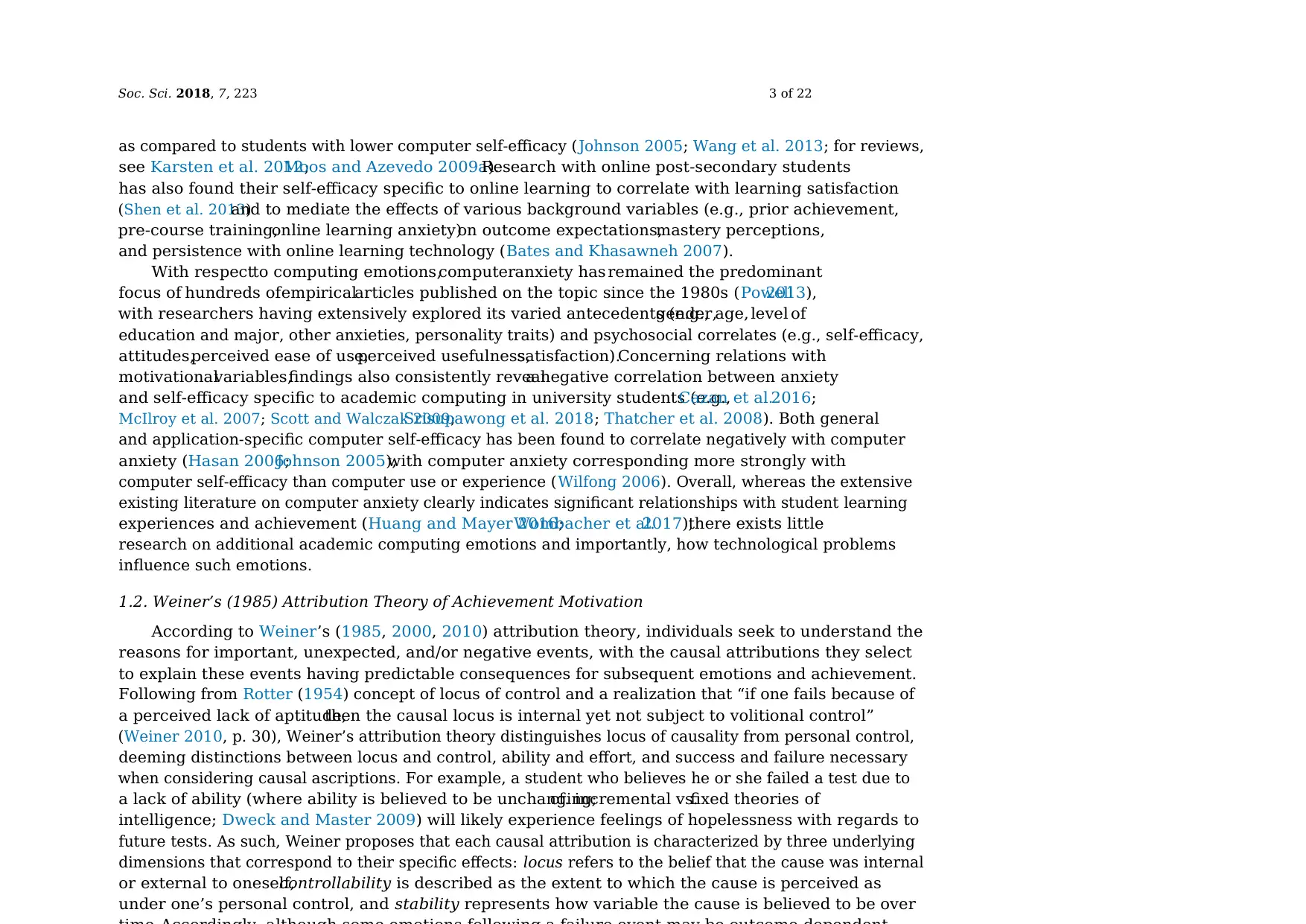
Soc. Sci. 2018, 7, 223 3 of 22
as compared to students with lower computer self-efficacy (Johnson 2005; Wang et al. 2013; for reviews,
see Karsten et al. 2012;Moos and Azevedo 2009a).Research with online post-secondary students
has also found their self-efficacy specific to online learning to correlate with learning satisfaction
(Shen et al. 2013)and to mediate the effects of various background variables (e.g., prior achievement,
pre-course training,online learning anxiety)on outcome expectations,mastery perceptions,
and persistence with online learning technology (Bates and Khasawneh 2007).
With respectto computing emotions,computeranxiety has remained the predominant
focus of hundreds ofempiricalarticles published on the topic since the 1980s (Powell2013),
with researchers having extensively explored its varied antecedents (e.g.,gender,age, level of
education and major, other anxieties, personality traits) and psychosocial correlates (e.g., self-efficacy,
attitudes,perceived ease of use,perceived usefulness,satisfaction).Concerning relations with
motivationalvariables,findings also consistently reveala negative correlation between anxiety
and self-efficacy specific to academic computing in university students (e.g.,Cazan et al.2016;
McIlroy et al. 2007; Scott and Walczak 2009;Srisupawong et al. 2018; Thatcher et al. 2008). Both general
and application-specific computer self-efficacy has been found to correlate negatively with computer
anxiety (Hasan 2006;Johnson 2005),with computer anxiety corresponding more strongly with
computer self-efficacy than computer use or experience (Wilfong 2006). Overall, whereas the extensive
existing literature on computer anxiety clearly indicates significant relationships with student learning
experiences and achievement (Huang and Mayer 2016;Wombacher et al.2017),there exists little
research on additional academic computing emotions and importantly, how technological problems
influence such emotions.
1.2. Weiner’s (1985) Attribution Theory of Achievement Motivation
According to Weiner’s (1985, 2000, 2010) attribution theory, individuals seek to understand the
reasons for important, unexpected, and/or negative events, with the causal attributions they select
to explain these events having predictable consequences for subsequent emotions and achievement.
Following from Rotter (1954) concept of locus of control and a realization that “if one fails because of
a perceived lack of aptitude,then the causal locus is internal yet not subject to volitional control”
(Weiner 2010, p. 30), Weiner’s attribution theory distinguishes locus of causality from personal control,
deeming distinctions between locus and control, ability and effort, and success and failure necessary
when considering causal ascriptions. For example, a student who believes he or she failed a test due to
a lack of ability (where ability is believed to be unchanging;cf. incremental vs.fixed theories of
intelligence; Dweck and Master 2009) will likely experience feelings of hopelessness with regards to
future tests. As such, Weiner proposes that each causal attribution is characterized by three underlying
dimensions that correspond to their specific effects: locus refers to the belief that the cause was internal
or external to oneself,controllability is described as the extent to which the cause is perceived as
under one’s personal control, and stability represents how variable the cause is believed to be over
as compared to students with lower computer self-efficacy (Johnson 2005; Wang et al. 2013; for reviews,
see Karsten et al. 2012;Moos and Azevedo 2009a).Research with online post-secondary students
has also found their self-efficacy specific to online learning to correlate with learning satisfaction
(Shen et al. 2013)and to mediate the effects of various background variables (e.g., prior achievement,
pre-course training,online learning anxiety)on outcome expectations,mastery perceptions,
and persistence with online learning technology (Bates and Khasawneh 2007).
With respectto computing emotions,computeranxiety has remained the predominant
focus of hundreds ofempiricalarticles published on the topic since the 1980s (Powell2013),
with researchers having extensively explored its varied antecedents (e.g.,gender,age, level of
education and major, other anxieties, personality traits) and psychosocial correlates (e.g., self-efficacy,
attitudes,perceived ease of use,perceived usefulness,satisfaction).Concerning relations with
motivationalvariables,findings also consistently reveala negative correlation between anxiety
and self-efficacy specific to academic computing in university students (e.g.,Cazan et al.2016;
McIlroy et al. 2007; Scott and Walczak 2009;Srisupawong et al. 2018; Thatcher et al. 2008). Both general
and application-specific computer self-efficacy has been found to correlate negatively with computer
anxiety (Hasan 2006;Johnson 2005),with computer anxiety corresponding more strongly with
computer self-efficacy than computer use or experience (Wilfong 2006). Overall, whereas the extensive
existing literature on computer anxiety clearly indicates significant relationships with student learning
experiences and achievement (Huang and Mayer 2016;Wombacher et al.2017),there exists little
research on additional academic computing emotions and importantly, how technological problems
influence such emotions.
1.2. Weiner’s (1985) Attribution Theory of Achievement Motivation
According to Weiner’s (1985, 2000, 2010) attribution theory, individuals seek to understand the
reasons for important, unexpected, and/or negative events, with the causal attributions they select
to explain these events having predictable consequences for subsequent emotions and achievement.
Following from Rotter (1954) concept of locus of control and a realization that “if one fails because of
a perceived lack of aptitude,then the causal locus is internal yet not subject to volitional control”
(Weiner 2010, p. 30), Weiner’s attribution theory distinguishes locus of causality from personal control,
deeming distinctions between locus and control, ability and effort, and success and failure necessary
when considering causal ascriptions. For example, a student who believes he or she failed a test due to
a lack of ability (where ability is believed to be unchanging;cf. incremental vs.fixed theories of
intelligence; Dweck and Master 2009) will likely experience feelings of hopelessness with regards to
future tests. As such, Weiner proposes that each causal attribution is characterized by three underlying
dimensions that correspond to their specific effects: locus refers to the belief that the cause was internal
or external to oneself,controllability is described as the extent to which the cause is perceived as
under one’s personal control, and stability represents how variable the cause is believed to be over
⊘ This is a preview!⊘
Do you want full access?
Subscribe today to unlock all pages.

Trusted by 1+ million students worldwide
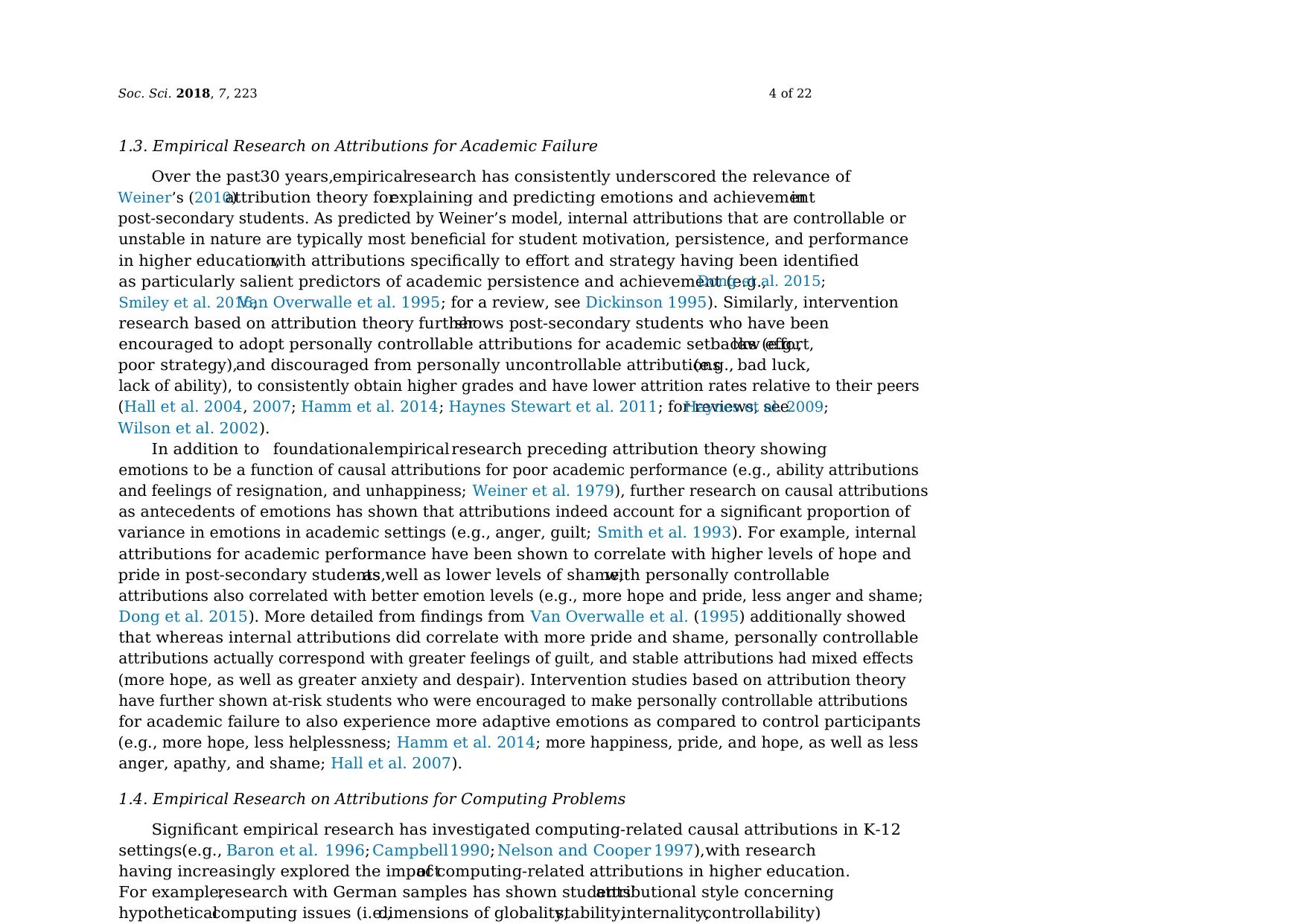
Soc. Sci. 2018, 7, 223 4 of 22
1.3. Empirical Research on Attributions for Academic Failure
Over the past30 years,empiricalresearch has consistently underscored the relevance of
Weiner’s (2010)attribution theory forexplaining and predicting emotions and achievementin
post-secondary students. As predicted by Weiner’s model, internal attributions that are controllable or
unstable in nature are typically most beneficial for student motivation, persistence, and performance
in higher education,with attributions specifically to effort and strategy having been identified
as particularly salient predictors of academic persistence and achievement (e.g.,Dong et al. 2015;
Smiley et al. 2016;Van Overwalle et al. 1995; for a review, see Dickinson 1995). Similarly, intervention
research based on attribution theory furthershows post-secondary students who have been
encouraged to adopt personally controllable attributions for academic setbacks (e.g.,low effort,
poor strategy),and discouraged from personally uncontrollable attributions(e.g., bad luck,
lack of ability), to consistently obtain higher grades and have lower attrition rates relative to their peers
(Hall et al. 2004, 2007; Hamm et al. 2014; Haynes Stewart et al. 2011; for reviews, seeHaynes et al. 2009;
Wilson et al. 2002).
In addition to foundationalempirical research preceding attribution theory showing
emotions to be a function of causal attributions for poor academic performance (e.g., ability attributions
and feelings of resignation, and unhappiness; Weiner et al. 1979), further research on causal attributions
as antecedents of emotions has shown that attributions indeed account for a significant proportion of
variance in emotions in academic settings (e.g., anger, guilt; Smith et al. 1993). For example, internal
attributions for academic performance have been shown to correlate with higher levels of hope and
pride in post-secondary students,as well as lower levels of shame,with personally controllable
attributions also correlated with better emotion levels (e.g., more hope and pride, less anger and shame;
Dong et al. 2015). More detailed from findings from Van Overwalle et al. (1995) additionally showed
that whereas internal attributions did correlate with more pride and shame, personally controllable
attributions actually correspond with greater feelings of guilt, and stable attributions had mixed effects
(more hope, as well as greater anxiety and despair). Intervention studies based on attribution theory
have further shown at-risk students who were encouraged to make personally controllable attributions
for academic failure to also experience more adaptive emotions as compared to control participants
(e.g., more hope, less helplessness; Hamm et al. 2014; more happiness, pride, and hope, as well as less
anger, apathy, and shame; Hall et al. 2007).
1.4. Empirical Research on Attributions for Computing Problems
Significant empirical research has investigated computing-related causal attributions in K-12
settings(e.g., Baron et al. 1996; Campbell1990; Nelson and Cooper 1997),with research
having increasingly explored the impactof computing-related attributions in higher education.
For example,research with German samples has shown students’attributional style concerning
hypotheticalcomputing issues (i.e.,dimensions of globality,stability,internality,controllability)
1.3. Empirical Research on Attributions for Academic Failure
Over the past30 years,empiricalresearch has consistently underscored the relevance of
Weiner’s (2010)attribution theory forexplaining and predicting emotions and achievementin
post-secondary students. As predicted by Weiner’s model, internal attributions that are controllable or
unstable in nature are typically most beneficial for student motivation, persistence, and performance
in higher education,with attributions specifically to effort and strategy having been identified
as particularly salient predictors of academic persistence and achievement (e.g.,Dong et al. 2015;
Smiley et al. 2016;Van Overwalle et al. 1995; for a review, see Dickinson 1995). Similarly, intervention
research based on attribution theory furthershows post-secondary students who have been
encouraged to adopt personally controllable attributions for academic setbacks (e.g.,low effort,
poor strategy),and discouraged from personally uncontrollable attributions(e.g., bad luck,
lack of ability), to consistently obtain higher grades and have lower attrition rates relative to their peers
(Hall et al. 2004, 2007; Hamm et al. 2014; Haynes Stewart et al. 2011; for reviews, seeHaynes et al. 2009;
Wilson et al. 2002).
In addition to foundationalempirical research preceding attribution theory showing
emotions to be a function of causal attributions for poor academic performance (e.g., ability attributions
and feelings of resignation, and unhappiness; Weiner et al. 1979), further research on causal attributions
as antecedents of emotions has shown that attributions indeed account for a significant proportion of
variance in emotions in academic settings (e.g., anger, guilt; Smith et al. 1993). For example, internal
attributions for academic performance have been shown to correlate with higher levels of hope and
pride in post-secondary students,as well as lower levels of shame,with personally controllable
attributions also correlated with better emotion levels (e.g., more hope and pride, less anger and shame;
Dong et al. 2015). More detailed from findings from Van Overwalle et al. (1995) additionally showed
that whereas internal attributions did correlate with more pride and shame, personally controllable
attributions actually correspond with greater feelings of guilt, and stable attributions had mixed effects
(more hope, as well as greater anxiety and despair). Intervention studies based on attribution theory
have further shown at-risk students who were encouraged to make personally controllable attributions
for academic failure to also experience more adaptive emotions as compared to control participants
(e.g., more hope, less helplessness; Hamm et al. 2014; more happiness, pride, and hope, as well as less
anger, apathy, and shame; Hall et al. 2007).
1.4. Empirical Research on Attributions for Computing Problems
Significant empirical research has investigated computing-related causal attributions in K-12
settings(e.g., Baron et al. 1996; Campbell1990; Nelson and Cooper 1997),with research
having increasingly explored the impactof computing-related attributions in higher education.
For example,research with German samples has shown students’attributional style concerning
hypotheticalcomputing issues (i.e.,dimensions of globality,stability,internality,controllability)
Paraphrase This Document
Need a fresh take? Get an instant paraphrase of this document with our AI Paraphraser
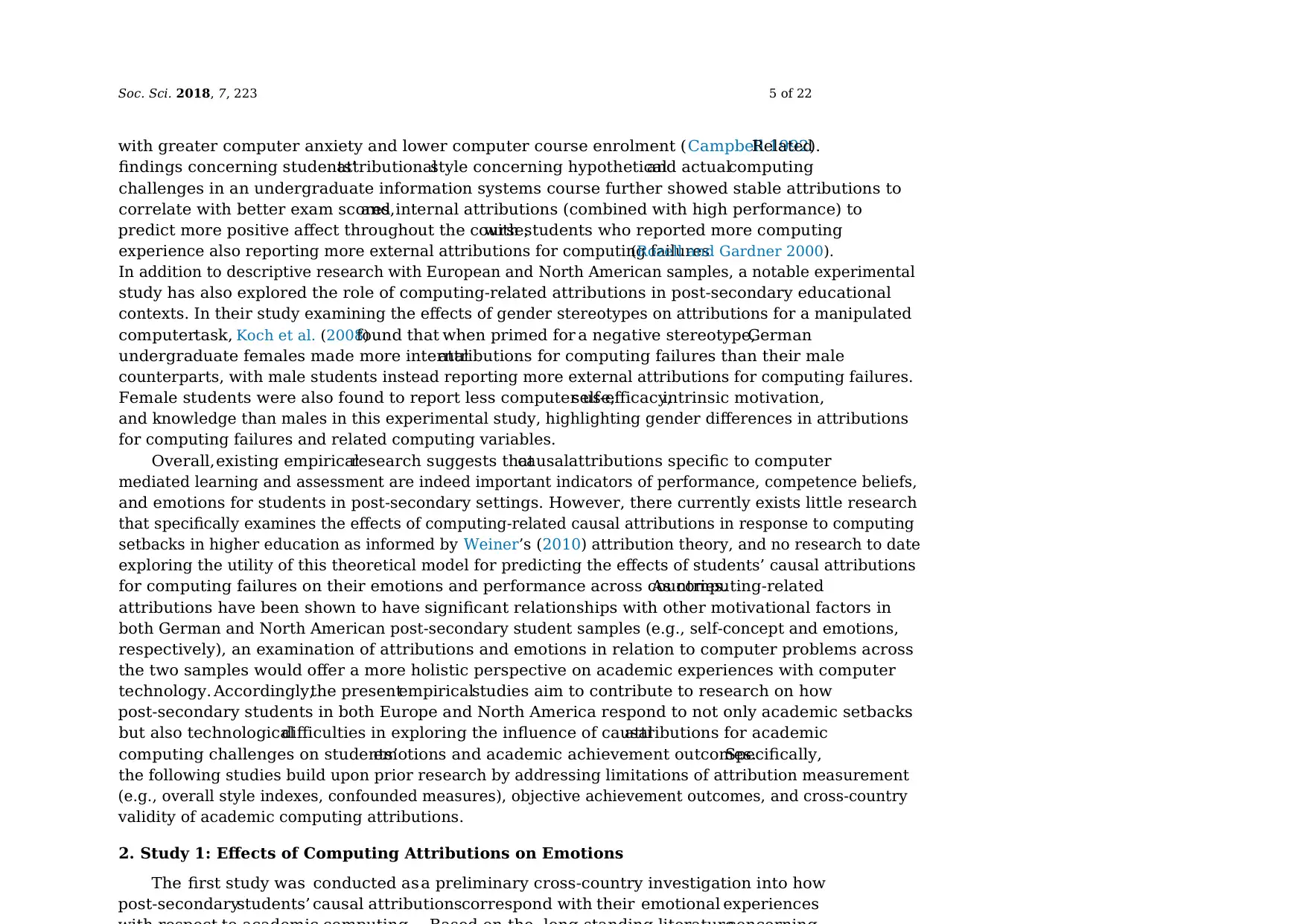
Soc. Sci. 2018, 7, 223 5 of 22
with greater computer anxiety and lower computer course enrolment (Campbell 1992).Related
findings concerning students’attributionalstyle concerning hypotheticaland actualcomputing
challenges in an undergraduate information systems course further showed stable attributions to
correlate with better exam scores,and internal attributions (combined with high performance) to
predict more positive affect throughout the course,with students who reported more computing
experience also reporting more external attributions for computing failures(Rozell and Gardner 2000).
In addition to descriptive research with European and North American samples, a notable experimental
study has also explored the role of computing-related attributions in post-secondary educational
contexts. In their study examining the effects of gender stereotypes on attributions for a manipulated
computertask, Koch et al. (2008)found that when primed for a negative stereotype,German
undergraduate females made more internalattributions for computing failures than their male
counterparts, with male students instead reporting more external attributions for computing failures.
Female students were also found to report less computer use,self-efficacy,intrinsic motivation,
and knowledge than males in this experimental study, highlighting gender differences in attributions
for computing failures and related computing variables.
Overall,existing empiricalresearch suggests thatcausalattributions specific to computer
mediated learning and assessment are indeed important indicators of performance, competence beliefs,
and emotions for students in post-secondary settings. However, there currently exists little research
that specifically examines the effects of computing-related causal attributions in response to computing
setbacks in higher education as informed by Weiner’s (2010) attribution theory, and no research to date
exploring the utility of this theoretical model for predicting the effects of students’ causal attributions
for computing failures on their emotions and performance across countries.As computing-related
attributions have been shown to have significant relationships with other motivational factors in
both German and North American post-secondary student samples (e.g., self-concept and emotions,
respectively), an examination of attributions and emotions in relation to computer problems across
the two samples would offer a more holistic perspective on academic experiences with computer
technology. Accordingly,the presentempiricalstudies aim to contribute to research on how
post-secondary students in both Europe and North America respond to not only academic setbacks
but also technologicaldifficulties in exploring the influence of causalattributions for academic
computing challenges on students’emotions and academic achievement outcomes.Specifically,
the following studies build upon prior research by addressing limitations of attribution measurement
(e.g., overall style indexes, confounded measures), objective achievement outcomes, and cross-country
validity of academic computing attributions.
2. Study 1: Effects of Computing Attributions on Emotions
The first study was conducted as a preliminary cross-country investigation into how
post-secondarystudents’ causal attributionscorrespond with their emotional experiences
with greater computer anxiety and lower computer course enrolment (Campbell 1992).Related
findings concerning students’attributionalstyle concerning hypotheticaland actualcomputing
challenges in an undergraduate information systems course further showed stable attributions to
correlate with better exam scores,and internal attributions (combined with high performance) to
predict more positive affect throughout the course,with students who reported more computing
experience also reporting more external attributions for computing failures(Rozell and Gardner 2000).
In addition to descriptive research with European and North American samples, a notable experimental
study has also explored the role of computing-related attributions in post-secondary educational
contexts. In their study examining the effects of gender stereotypes on attributions for a manipulated
computertask, Koch et al. (2008)found that when primed for a negative stereotype,German
undergraduate females made more internalattributions for computing failures than their male
counterparts, with male students instead reporting more external attributions for computing failures.
Female students were also found to report less computer use,self-efficacy,intrinsic motivation,
and knowledge than males in this experimental study, highlighting gender differences in attributions
for computing failures and related computing variables.
Overall,existing empiricalresearch suggests thatcausalattributions specific to computer
mediated learning and assessment are indeed important indicators of performance, competence beliefs,
and emotions for students in post-secondary settings. However, there currently exists little research
that specifically examines the effects of computing-related causal attributions in response to computing
setbacks in higher education as informed by Weiner’s (2010) attribution theory, and no research to date
exploring the utility of this theoretical model for predicting the effects of students’ causal attributions
for computing failures on their emotions and performance across countries.As computing-related
attributions have been shown to have significant relationships with other motivational factors in
both German and North American post-secondary student samples (e.g., self-concept and emotions,
respectively), an examination of attributions and emotions in relation to computer problems across
the two samples would offer a more holistic perspective on academic experiences with computer
technology. Accordingly,the presentempiricalstudies aim to contribute to research on how
post-secondary students in both Europe and North America respond to not only academic setbacks
but also technologicaldifficulties in exploring the influence of causalattributions for academic
computing challenges on students’emotions and academic achievement outcomes.Specifically,
the following studies build upon prior research by addressing limitations of attribution measurement
(e.g., overall style indexes, confounded measures), objective achievement outcomes, and cross-country
validity of academic computing attributions.
2. Study 1: Effects of Computing Attributions on Emotions
The first study was conducted as a preliminary cross-country investigation into how
post-secondarystudents’ causal attributionscorrespond with their emotional experiences
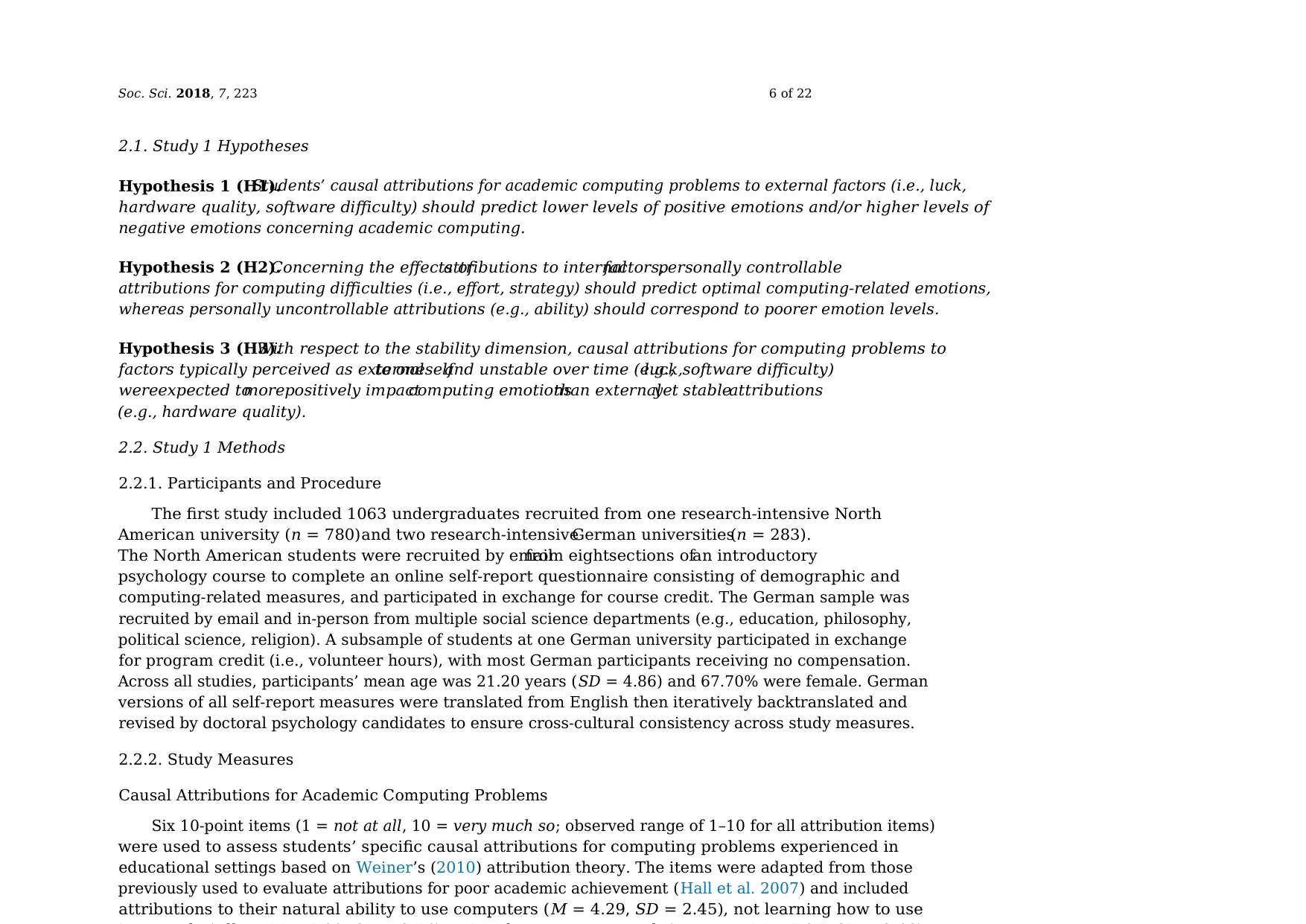
Soc. Sci. 2018, 7, 223 6 of 22
2.1. Study 1 Hypotheses
Hypothesis 1 (H1).Students’ causal attributions for academic computing problems to external factors (i.e., luck,
hardware quality, software difficulty) should predict lower levels of positive emotions and/or higher levels of
negative emotions concerning academic computing.
Hypothesis 2 (H2).Concerning the effects ofattributions to internalfactors,personally controllable
attributions for computing difficulties (i.e., effort, strategy) should predict optimal computing-related emotions,
whereas personally uncontrollable attributions (e.g., ability) should correspond to poorer emotion levels.
Hypothesis 3 (H3).With respect to the stability dimension, causal attributions for computing problems to
factors typically perceived as externalto oneselfand unstable over time (e.g.,luck,software difficulty)
wereexpected tomorepositively impactcomputing emotionsthan externalyet stableattributions
(e.g., hardware quality).
2.2. Study 1 Methods
2.2.1. Participants and Procedure
The first study included 1063 undergraduates recruited from one research-intensive North
American university (n = 780)and two research-intensiveGerman universities(n = 283).
The North American students were recruited by emailfrom eightsections ofan introductory
psychology course to complete an online self-report questionnaire consisting of demographic and
computing-related measures, and participated in exchange for course credit. The German sample was
recruited by email and in-person from multiple social science departments (e.g., education, philosophy,
political science, religion). A subsample of students at one German university participated in exchange
for program credit (i.e., volunteer hours), with most German participants receiving no compensation.
Across all studies, participants’ mean age was 21.20 years (SD = 4.86) and 67.70% were female. German
versions of all self-report measures were translated from English then iteratively backtranslated and
revised by doctoral psychology candidates to ensure cross-cultural consistency across study measures.
2.2.2. Study Measures
Causal Attributions for Academic Computing Problems
Six 10-point items (1 = not at all, 10 = very much so; observed range of 1–10 for all attribution items)
were used to assess students’ specific causal attributions for computing problems experienced in
educational settings based on Weiner’s (2010) attribution theory. The items were adapted from those
previously used to evaluate attributions for poor academic achievement (Hall et al. 2007) and included
attributions to their natural ability to use computers (M = 4.29, SD = 2.45), not learning how to use
2.1. Study 1 Hypotheses
Hypothesis 1 (H1).Students’ causal attributions for academic computing problems to external factors (i.e., luck,
hardware quality, software difficulty) should predict lower levels of positive emotions and/or higher levels of
negative emotions concerning academic computing.
Hypothesis 2 (H2).Concerning the effects ofattributions to internalfactors,personally controllable
attributions for computing difficulties (i.e., effort, strategy) should predict optimal computing-related emotions,
whereas personally uncontrollable attributions (e.g., ability) should correspond to poorer emotion levels.
Hypothesis 3 (H3).With respect to the stability dimension, causal attributions for computing problems to
factors typically perceived as externalto oneselfand unstable over time (e.g.,luck,software difficulty)
wereexpected tomorepositively impactcomputing emotionsthan externalyet stableattributions
(e.g., hardware quality).
2.2. Study 1 Methods
2.2.1. Participants and Procedure
The first study included 1063 undergraduates recruited from one research-intensive North
American university (n = 780)and two research-intensiveGerman universities(n = 283).
The North American students were recruited by emailfrom eightsections ofan introductory
psychology course to complete an online self-report questionnaire consisting of demographic and
computing-related measures, and participated in exchange for course credit. The German sample was
recruited by email and in-person from multiple social science departments (e.g., education, philosophy,
political science, religion). A subsample of students at one German university participated in exchange
for program credit (i.e., volunteer hours), with most German participants receiving no compensation.
Across all studies, participants’ mean age was 21.20 years (SD = 4.86) and 67.70% were female. German
versions of all self-report measures were translated from English then iteratively backtranslated and
revised by doctoral psychology candidates to ensure cross-cultural consistency across study measures.
2.2.2. Study Measures
Causal Attributions for Academic Computing Problems
Six 10-point items (1 = not at all, 10 = very much so; observed range of 1–10 for all attribution items)
were used to assess students’ specific causal attributions for computing problems experienced in
educational settings based on Weiner’s (2010) attribution theory. The items were adapted from those
previously used to evaluate attributions for poor academic achievement (Hall et al. 2007) and included
attributions to their natural ability to use computers (M = 4.29, SD = 2.45), not learning how to use
⊘ This is a preview!⊘
Do you want full access?
Subscribe today to unlock all pages.

Trusted by 1+ million students worldwide
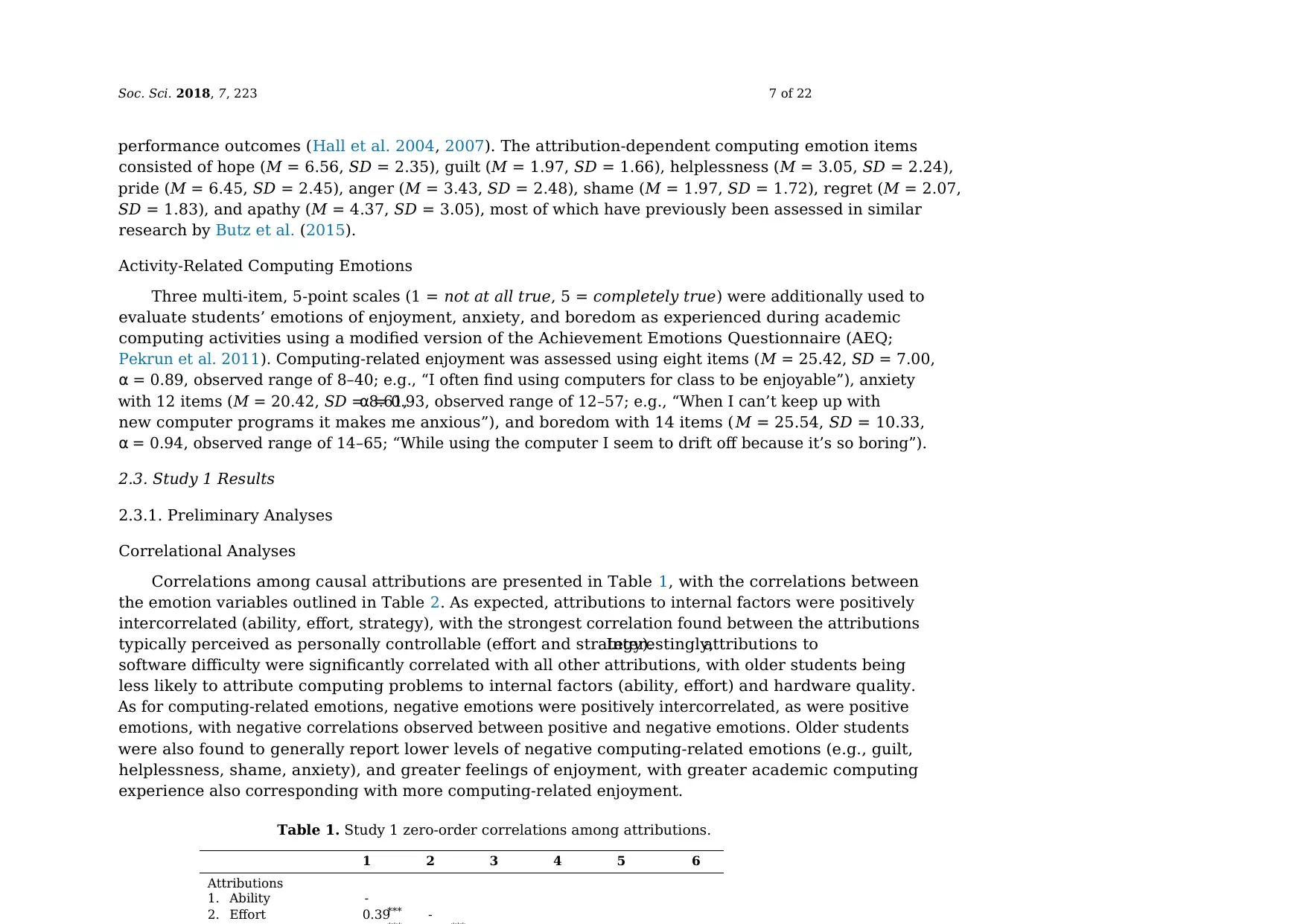
Soc. Sci. 2018, 7, 223 7 of 22
performance outcomes (Hall et al. 2004, 2007). The attribution-dependent computing emotion items
consisted of hope (M = 6.56, SD = 2.35), guilt (M = 1.97, SD = 1.66), helplessness (M = 3.05, SD = 2.24),
pride (M = 6.45, SD = 2.45), anger (M = 3.43, SD = 2.48), shame (M = 1.97, SD = 1.72), regret (M = 2.07,
SD = 1.83), and apathy (M = 4.37, SD = 3.05), most of which have previously been assessed in similar
research by Butz et al. (2015).
Activity-Related Computing Emotions
Three multi-item, 5-point scales (1 = not at all true, 5 = completely true) were additionally used to
evaluate students’ emotions of enjoyment, anxiety, and boredom as experienced during academic
computing activities using a modified version of the Achievement Emotions Questionnaire (AEQ;
Pekrun et al. 2011). Computing-related enjoyment was assessed using eight items (M = 25.42, SD = 7.00,
α = 0.89, observed range of 8–40; e.g., “I often find using computers for class to be enjoyable”), anxiety
with 12 items (M = 20.42, SD = 8.61,α = 0.93, observed range of 12–57; e.g., “When I can’t keep up with
new computer programs it makes me anxious”), and boredom with 14 items ( M = 25.54, SD = 10.33,
α = 0.94, observed range of 14–65; “While using the computer I seem to drift off because it’s so boring”).
2.3. Study 1 Results
2.3.1. Preliminary Analyses
Correlational Analyses
Correlations among causal attributions are presented in Table 1, with the correlations between
the emotion variables outlined in Table 2. As expected, attributions to internal factors were positively
intercorrelated (ability, effort, strategy), with the strongest correlation found between the attributions
typically perceived as personally controllable (effort and strategy).Interestingly,attributions to
software difficulty were significantly correlated with all other attributions, with older students being
less likely to attribute computing problems to internal factors (ability, effort) and hardware quality.
As for computing-related emotions, negative emotions were positively intercorrelated, as were positive
emotions, with negative correlations observed between positive and negative emotions. Older students
were also found to generally report lower levels of negative computing-related emotions (e.g., guilt,
helplessness, shame, anxiety), and greater feelings of enjoyment, with greater academic computing
experience also corresponding with more computing-related enjoyment.
Table 1. Study 1 zero-order correlations among attributions.
1 2 3 4 5 6
Attributions
1. Ability -
2. Effort 0.39*** -
performance outcomes (Hall et al. 2004, 2007). The attribution-dependent computing emotion items
consisted of hope (M = 6.56, SD = 2.35), guilt (M = 1.97, SD = 1.66), helplessness (M = 3.05, SD = 2.24),
pride (M = 6.45, SD = 2.45), anger (M = 3.43, SD = 2.48), shame (M = 1.97, SD = 1.72), regret (M = 2.07,
SD = 1.83), and apathy (M = 4.37, SD = 3.05), most of which have previously been assessed in similar
research by Butz et al. (2015).
Activity-Related Computing Emotions
Three multi-item, 5-point scales (1 = not at all true, 5 = completely true) were additionally used to
evaluate students’ emotions of enjoyment, anxiety, and boredom as experienced during academic
computing activities using a modified version of the Achievement Emotions Questionnaire (AEQ;
Pekrun et al. 2011). Computing-related enjoyment was assessed using eight items (M = 25.42, SD = 7.00,
α = 0.89, observed range of 8–40; e.g., “I often find using computers for class to be enjoyable”), anxiety
with 12 items (M = 20.42, SD = 8.61,α = 0.93, observed range of 12–57; e.g., “When I can’t keep up with
new computer programs it makes me anxious”), and boredom with 14 items ( M = 25.54, SD = 10.33,
α = 0.94, observed range of 14–65; “While using the computer I seem to drift off because it’s so boring”).
2.3. Study 1 Results
2.3.1. Preliminary Analyses
Correlational Analyses
Correlations among causal attributions are presented in Table 1, with the correlations between
the emotion variables outlined in Table 2. As expected, attributions to internal factors were positively
intercorrelated (ability, effort, strategy), with the strongest correlation found between the attributions
typically perceived as personally controllable (effort and strategy).Interestingly,attributions to
software difficulty were significantly correlated with all other attributions, with older students being
less likely to attribute computing problems to internal factors (ability, effort) and hardware quality.
As for computing-related emotions, negative emotions were positively intercorrelated, as were positive
emotions, with negative correlations observed between positive and negative emotions. Older students
were also found to generally report lower levels of negative computing-related emotions (e.g., guilt,
helplessness, shame, anxiety), and greater feelings of enjoyment, with greater academic computing
experience also corresponding with more computing-related enjoyment.
Table 1. Study 1 zero-order correlations among attributions.
1 2 3 4 5 6
Attributions
1. Ability -
2. Effort 0.39*** -
Paraphrase This Document
Need a fresh take? Get an instant paraphrase of this document with our AI Paraphraser
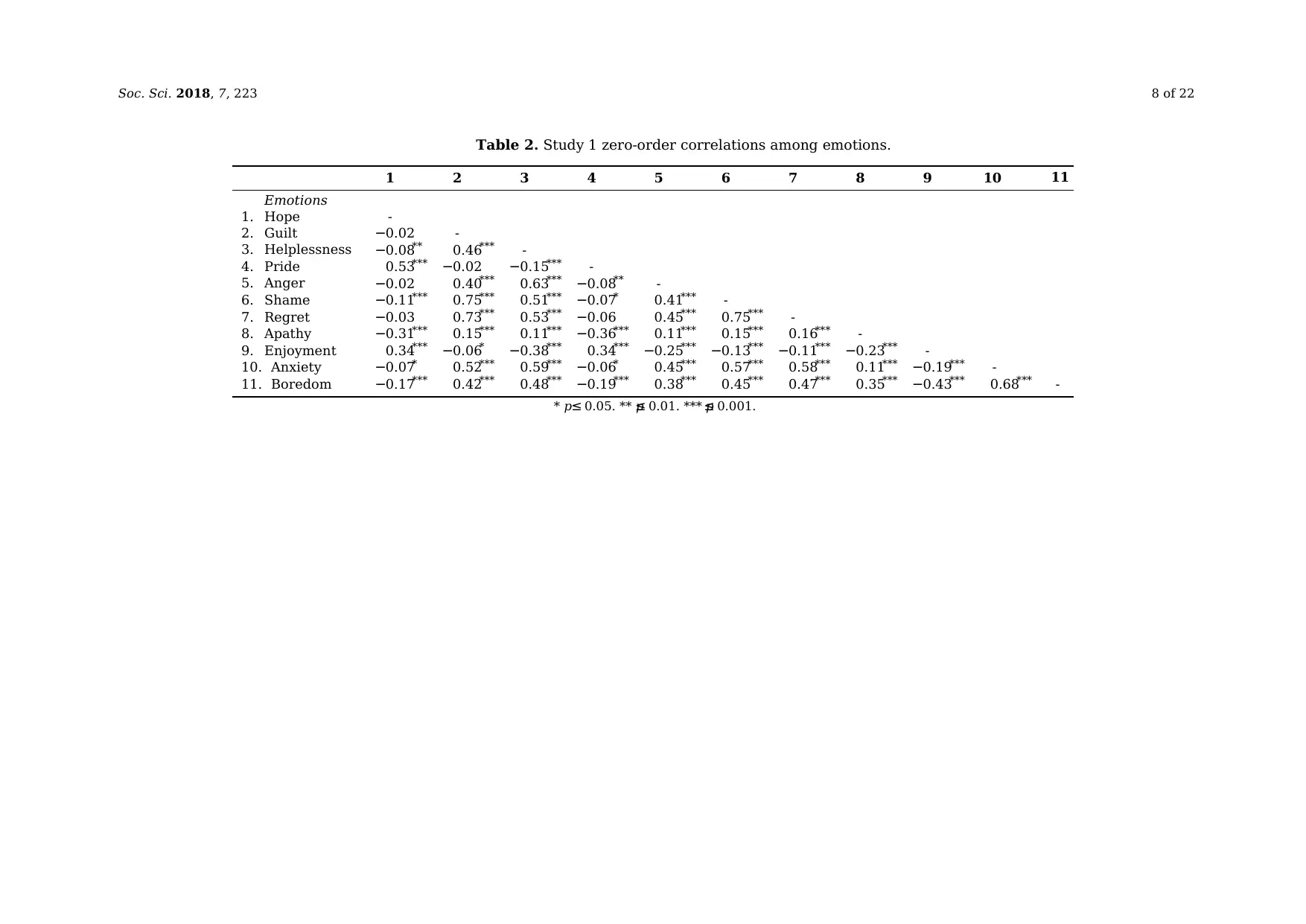
Soc. Sci. 2018, 7, 223 8 of 22
Table 2. Study 1 zero-order correlations among emotions.
1 2 3 4 5 6 7 8 9 10 11
Emotions
1. Hope -
2. Guilt −0.02 -
3. Helplessness −0.08** 0.46*** -
4. Pride 0.53*** −0.02 −0.15*** -
5. Anger −0.02 0.40*** 0.63*** −0.08** -
6. Shame −0.11*** 0.75*** 0.51*** −0.07* 0.41*** -
7. Regret −0.03 0.73*** 0.53*** −0.06 0.45*** 0.75*** -
8. Apathy −0.31*** 0.15*** 0.11*** −0.36*** 0.11*** 0.15*** 0.16*** -
9. Enjoyment 0.34*** −0.06* −0.38*** 0.34*** −0.25*** −0.13*** −0.11*** −0.23*** -
10. Anxiety −0.07* 0.52*** 0.59*** −0.06* 0.45*** 0.57*** 0.58*** 0.11*** −0.19*** -
11. Boredom −0.17*** 0.42*** 0.48*** −0.19*** 0.38*** 0.45*** 0.47*** 0.35*** −0.43*** 0.68*** -
* p≤ 0.05. ** p≤ 0.01. *** p≤ 0.001.
Table 2. Study 1 zero-order correlations among emotions.
1 2 3 4 5 6 7 8 9 10 11
Emotions
1. Hope -
2. Guilt −0.02 -
3. Helplessness −0.08** 0.46*** -
4. Pride 0.53*** −0.02 −0.15*** -
5. Anger −0.02 0.40*** 0.63*** −0.08** -
6. Shame −0.11*** 0.75*** 0.51*** −0.07* 0.41*** -
7. Regret −0.03 0.73*** 0.53*** −0.06 0.45*** 0.75*** -
8. Apathy −0.31*** 0.15*** 0.11*** −0.36*** 0.11*** 0.15*** 0.16*** -
9. Enjoyment 0.34*** −0.06* −0.38*** 0.34*** −0.25*** −0.13*** −0.11*** −0.23*** -
10. Anxiety −0.07* 0.52*** 0.59*** −0.06* 0.45*** 0.57*** 0.58*** 0.11*** −0.19*** -
11. Boredom −0.17*** 0.42*** 0.48*** −0.19*** 0.38*** 0.45*** 0.47*** 0.35*** −0.43*** 0.68*** -
* p≤ 0.05. ** p≤ 0.01. *** p≤ 0.001.
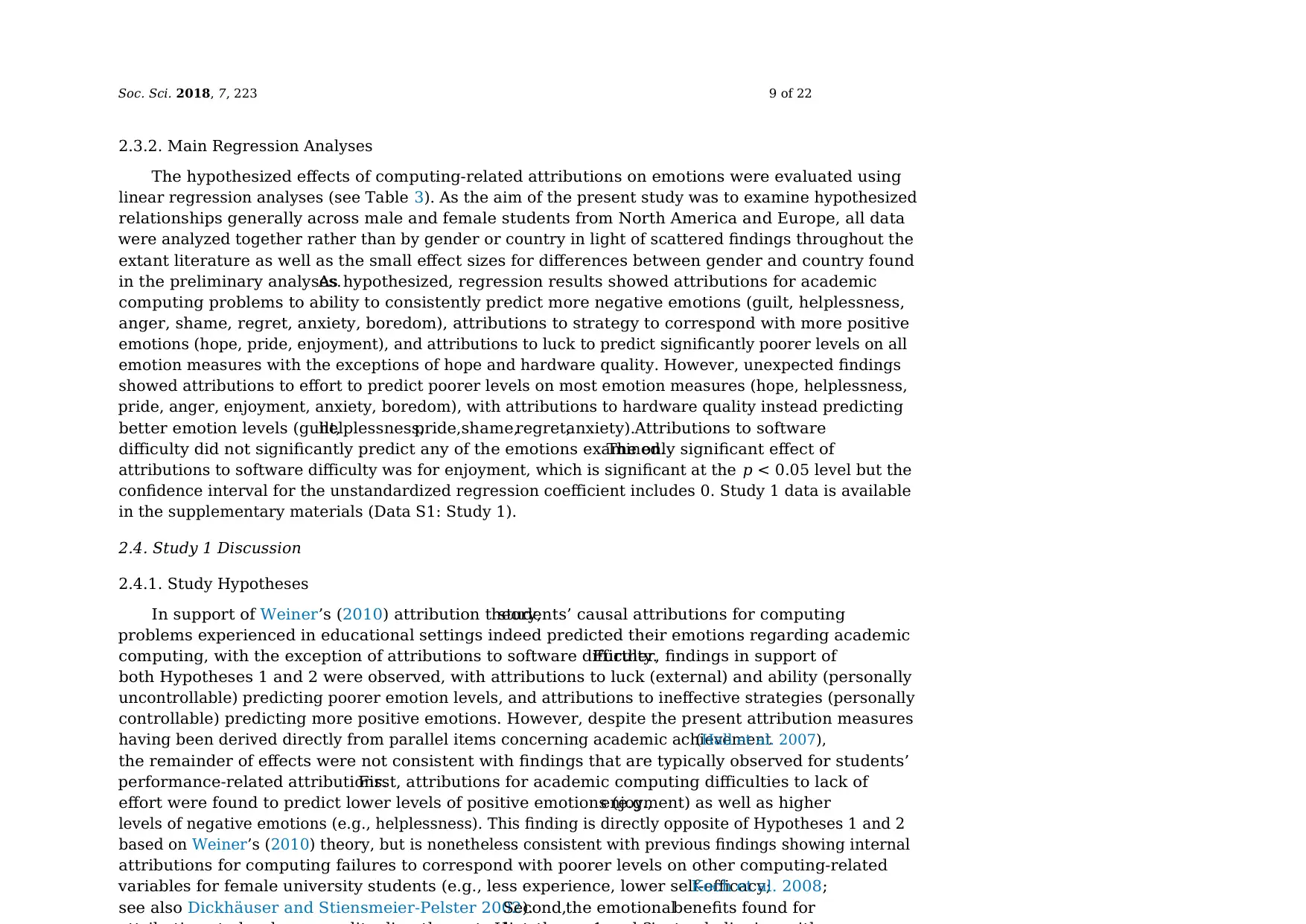
Soc. Sci. 2018, 7, 223 9 of 22
2.3.2. Main Regression Analyses
The hypothesized effects of computing-related attributions on emotions were evaluated using
linear regression analyses (see Table 3). As the aim of the present study was to examine hypothesized
relationships generally across male and female students from North America and Europe, all data
were analyzed together rather than by gender or country in light of scattered findings throughout the
extant literature as well as the small effect sizes for differences between gender and country found
in the preliminary analyses.As hypothesized, regression results showed attributions for academic
computing problems to ability to consistently predict more negative emotions (guilt, helplessness,
anger, shame, regret, anxiety, boredom), attributions to strategy to correspond with more positive
emotions (hope, pride, enjoyment), and attributions to luck to predict significantly poorer levels on all
emotion measures with the exceptions of hope and hardware quality. However, unexpected findings
showed attributions to effort to predict poorer levels on most emotion measures (hope, helplessness,
pride, anger, enjoyment, anxiety, boredom), with attributions to hardware quality instead predicting
better emotion levels (guilt,helplessness,pride,shame,regret,anxiety).Attributions to software
difficulty did not significantly predict any of the emotions examined.The only significant effect of
attributions to software difficulty was for enjoyment, which is significant at the p < 0.05 level but the
confidence interval for the unstandardized regression coefficient includes 0. Study 1 data is available
in the supplementary materials (Data S1: Study 1).
2.4. Study 1 Discussion
2.4.1. Study Hypotheses
In support of Weiner’s (2010) attribution theory,students’ causal attributions for computing
problems experienced in educational settings indeed predicted their emotions regarding academic
computing, with the exception of attributions to software difficulty.Further, findings in support of
both Hypotheses 1 and 2 were observed, with attributions to luck (external) and ability (personally
uncontrollable) predicting poorer emotion levels, and attributions to ineffective strategies (personally
controllable) predicting more positive emotions. However, despite the present attribution measures
having been derived directly from parallel items concerning academic achievement(Hall et al. 2007),
the remainder of effects were not consistent with findings that are typically observed for students’
performance-related attributions.First, attributions for academic computing difficulties to lack of
effort were found to predict lower levels of positive emotions (e.g.,enjoyment) as well as higher
levels of negative emotions (e.g., helplessness). This finding is directly opposite of Hypotheses 1 and 2
based on Weiner’s (2010) theory, but is nonetheless consistent with previous findings showing internal
attributions for computing failures to correspond with poorer levels on other computing-related
variables for female university students (e.g., less experience, lower self-efficacy;Koch et al. 2008;
see also Dickhäuser and Stiensmeier-Pelster 2002).Second,the emotionalbenefits found for
2.3.2. Main Regression Analyses
The hypothesized effects of computing-related attributions on emotions were evaluated using
linear regression analyses (see Table 3). As the aim of the present study was to examine hypothesized
relationships generally across male and female students from North America and Europe, all data
were analyzed together rather than by gender or country in light of scattered findings throughout the
extant literature as well as the small effect sizes for differences between gender and country found
in the preliminary analyses.As hypothesized, regression results showed attributions for academic
computing problems to ability to consistently predict more negative emotions (guilt, helplessness,
anger, shame, regret, anxiety, boredom), attributions to strategy to correspond with more positive
emotions (hope, pride, enjoyment), and attributions to luck to predict significantly poorer levels on all
emotion measures with the exceptions of hope and hardware quality. However, unexpected findings
showed attributions to effort to predict poorer levels on most emotion measures (hope, helplessness,
pride, anger, enjoyment, anxiety, boredom), with attributions to hardware quality instead predicting
better emotion levels (guilt,helplessness,pride,shame,regret,anxiety).Attributions to software
difficulty did not significantly predict any of the emotions examined.The only significant effect of
attributions to software difficulty was for enjoyment, which is significant at the p < 0.05 level but the
confidence interval for the unstandardized regression coefficient includes 0. Study 1 data is available
in the supplementary materials (Data S1: Study 1).
2.4. Study 1 Discussion
2.4.1. Study Hypotheses
In support of Weiner’s (2010) attribution theory,students’ causal attributions for computing
problems experienced in educational settings indeed predicted their emotions regarding academic
computing, with the exception of attributions to software difficulty.Further, findings in support of
both Hypotheses 1 and 2 were observed, with attributions to luck (external) and ability (personally
uncontrollable) predicting poorer emotion levels, and attributions to ineffective strategies (personally
controllable) predicting more positive emotions. However, despite the present attribution measures
having been derived directly from parallel items concerning academic achievement(Hall et al. 2007),
the remainder of effects were not consistent with findings that are typically observed for students’
performance-related attributions.First, attributions for academic computing difficulties to lack of
effort were found to predict lower levels of positive emotions (e.g.,enjoyment) as well as higher
levels of negative emotions (e.g., helplessness). This finding is directly opposite of Hypotheses 1 and 2
based on Weiner’s (2010) theory, but is nonetheless consistent with previous findings showing internal
attributions for computing failures to correspond with poorer levels on other computing-related
variables for female university students (e.g., less experience, lower self-efficacy;Koch et al. 2008;
see also Dickhäuser and Stiensmeier-Pelster 2002).Second,the emotionalbenefits found for
⊘ This is a preview!⊘
Do you want full access?
Subscribe today to unlock all pages.

Trusted by 1+ million students worldwide
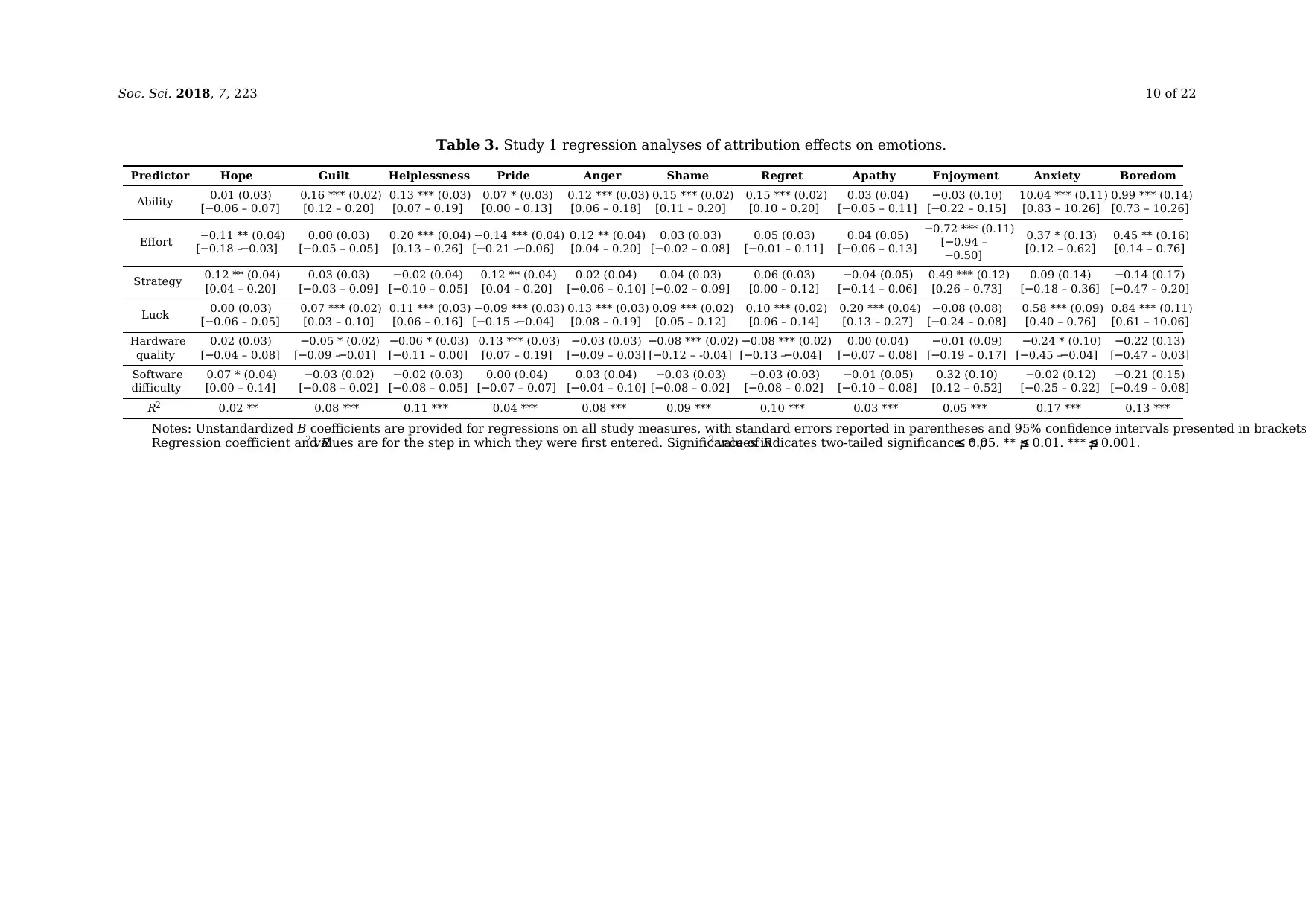
Soc. Sci. 2018, 7, 223 10 of 22
Table 3. Study 1 regression analyses of attribution effects on emotions.
Predictor Hope Guilt Helplessness Pride Anger Shame Regret Apathy Enjoyment Anxiety Boredom
Ability 0.01 (0.03)
[−0.06 – 0.07]
0.16 *** (0.02)
[0.12 – 0.20]
0.13 *** (0.03)
[0.07 – 0.19]
0.07 * (0.03)
[0.00 – 0.13]
0.12 *** (0.03)
[0.06 – 0.18]
0.15 *** (0.02)
[0.11 – 0.20]
0.15 *** (0.02)
[0.10 – 0.20]
0.03 (0.04)
[−0.05 – 0.11]
−0.03 (0.10)
[−0.22 – 0.15]
10.04 *** (0.11)
[0.83 – 10.26]
0.99 *** (0.14)
[0.73 – 10.26]
Effort −0.11 ** (0.04)
[−0.18 –−0.03]
0.00 (0.03)
[−0.05 – 0.05]
0.20 *** (0.04)
[0.13 – 0.26]
−0.14 *** (0.04)
[−0.21 –−0.06]
0.12 ** (0.04)
[0.04 – 0.20]
0.03 (0.03)
[−0.02 – 0.08]
0.05 (0.03)
[−0.01 – 0.11]
0.04 (0.05)
[−0.06 – 0.13]
−0.72 *** (0.11)
[−0.94 –
−0.50]
0.37 * (0.13)
[0.12 – 0.62]
0.45 ** (0.16)
[0.14 – 0.76]
Strategy 0.12 ** (0.04)
[0.04 – 0.20]
0.03 (0.03)
[−0.03 – 0.09]
−0.02 (0.04)
[−0.10 – 0.05]
0.12 ** (0.04)
[0.04 – 0.20]
0.02 (0.04)
[−0.06 – 0.10]
0.04 (0.03)
[−0.02 – 0.09]
0.06 (0.03)
[0.00 – 0.12]
−0.04 (0.05)
[−0.14 – 0.06]
0.49 *** (0.12)
[0.26 – 0.73]
0.09 (0.14)
[−0.18 – 0.36]
−0.14 (0.17)
[−0.47 – 0.20]
Luck 0.00 (0.03)
[−0.06 – 0.05]
0.07 *** (0.02)
[0.03 – 0.10]
0.11 *** (0.03)
[0.06 – 0.16]
−0.09 *** (0.03)
[−0.15 –−0.04]
0.13 *** (0.03)
[0.08 – 0.19]
0.09 *** (0.02)
[0.05 – 0.12]
0.10 *** (0.02)
[0.06 – 0.14]
0.20 *** (0.04)
[0.13 – 0.27]
−0.08 (0.08)
[−0.24 – 0.08]
0.58 *** (0.09)
[0.40 – 0.76]
0.84 *** (0.11)
[0.61 – 10.06]
Hardware
quality
0.02 (0.03)
[−0.04 – 0.08]
−0.05 * (0.02)
[−0.09 –−0.01]
−0.06 * (0.03)
[−0.11 – 0.00]
0.13 *** (0.03)
[0.07 – 0.19]
−0.03 (0.03)
[−0.09 – 0.03]
−0.08 *** (0.02)
[−0.12 – -0.04]
−0.08 *** (0.02)
[−0.13 –−0.04]
0.00 (0.04)
[−0.07 – 0.08]
−0.01 (0.09)
[−0.19 – 0.17]
−0.24 * (0.10)
[−0.45 –−0.04]
−0.22 (0.13)
[−0.47 – 0.03]
Software
difficulty
0.07 * (0.04)
[0.00 – 0.14]
−0.03 (0.02)
[−0.08 – 0.02]
−0.02 (0.03)
[−0.08 – 0.05]
0.00 (0.04)
[−0.07 – 0.07]
0.03 (0.04)
[−0.04 – 0.10]
−0.03 (0.03)
[−0.08 – 0.02]
−0.03 (0.03)
[−0.08 – 0.02]
−0.01 (0.05)
[−0.10 – 0.08]
0.32 (0.10)
[0.12 – 0.52]
−0.02 (0.12)
[−0.25 – 0.22]
−0.21 (0.15)
[−0.49 – 0.08]
R2 0.02 ** 0.08 *** 0.11 *** 0.04 *** 0.08 *** 0.09 *** 0.10 *** 0.03 *** 0.05 *** 0.17 *** 0.13 ***
Notes: Unstandardized B coefficients are provided for regressions on all study measures, with standard errors reported in parentheses and 95% confidence intervals presented in brackets
Regression coefficient and R2 values are for the step in which they were first entered. Significance of R2 values indicates two-tailed significance. * p≤ 0.05. ** p≤ 0.01. *** p≤ 0.001.
Table 3. Study 1 regression analyses of attribution effects on emotions.
Predictor Hope Guilt Helplessness Pride Anger Shame Regret Apathy Enjoyment Anxiety Boredom
Ability 0.01 (0.03)
[−0.06 – 0.07]
0.16 *** (0.02)
[0.12 – 0.20]
0.13 *** (0.03)
[0.07 – 0.19]
0.07 * (0.03)
[0.00 – 0.13]
0.12 *** (0.03)
[0.06 – 0.18]
0.15 *** (0.02)
[0.11 – 0.20]
0.15 *** (0.02)
[0.10 – 0.20]
0.03 (0.04)
[−0.05 – 0.11]
−0.03 (0.10)
[−0.22 – 0.15]
10.04 *** (0.11)
[0.83 – 10.26]
0.99 *** (0.14)
[0.73 – 10.26]
Effort −0.11 ** (0.04)
[−0.18 –−0.03]
0.00 (0.03)
[−0.05 – 0.05]
0.20 *** (0.04)
[0.13 – 0.26]
−0.14 *** (0.04)
[−0.21 –−0.06]
0.12 ** (0.04)
[0.04 – 0.20]
0.03 (0.03)
[−0.02 – 0.08]
0.05 (0.03)
[−0.01 – 0.11]
0.04 (0.05)
[−0.06 – 0.13]
−0.72 *** (0.11)
[−0.94 –
−0.50]
0.37 * (0.13)
[0.12 – 0.62]
0.45 ** (0.16)
[0.14 – 0.76]
Strategy 0.12 ** (0.04)
[0.04 – 0.20]
0.03 (0.03)
[−0.03 – 0.09]
−0.02 (0.04)
[−0.10 – 0.05]
0.12 ** (0.04)
[0.04 – 0.20]
0.02 (0.04)
[−0.06 – 0.10]
0.04 (0.03)
[−0.02 – 0.09]
0.06 (0.03)
[0.00 – 0.12]
−0.04 (0.05)
[−0.14 – 0.06]
0.49 *** (0.12)
[0.26 – 0.73]
0.09 (0.14)
[−0.18 – 0.36]
−0.14 (0.17)
[−0.47 – 0.20]
Luck 0.00 (0.03)
[−0.06 – 0.05]
0.07 *** (0.02)
[0.03 – 0.10]
0.11 *** (0.03)
[0.06 – 0.16]
−0.09 *** (0.03)
[−0.15 –−0.04]
0.13 *** (0.03)
[0.08 – 0.19]
0.09 *** (0.02)
[0.05 – 0.12]
0.10 *** (0.02)
[0.06 – 0.14]
0.20 *** (0.04)
[0.13 – 0.27]
−0.08 (0.08)
[−0.24 – 0.08]
0.58 *** (0.09)
[0.40 – 0.76]
0.84 *** (0.11)
[0.61 – 10.06]
Hardware
quality
0.02 (0.03)
[−0.04 – 0.08]
−0.05 * (0.02)
[−0.09 –−0.01]
−0.06 * (0.03)
[−0.11 – 0.00]
0.13 *** (0.03)
[0.07 – 0.19]
−0.03 (0.03)
[−0.09 – 0.03]
−0.08 *** (0.02)
[−0.12 – -0.04]
−0.08 *** (0.02)
[−0.13 –−0.04]
0.00 (0.04)
[−0.07 – 0.08]
−0.01 (0.09)
[−0.19 – 0.17]
−0.24 * (0.10)
[−0.45 –−0.04]
−0.22 (0.13)
[−0.47 – 0.03]
Software
difficulty
0.07 * (0.04)
[0.00 – 0.14]
−0.03 (0.02)
[−0.08 – 0.02]
−0.02 (0.03)
[−0.08 – 0.05]
0.00 (0.04)
[−0.07 – 0.07]
0.03 (0.04)
[−0.04 – 0.10]
−0.03 (0.03)
[−0.08 – 0.02]
−0.03 (0.03)
[−0.08 – 0.02]
−0.01 (0.05)
[−0.10 – 0.08]
0.32 (0.10)
[0.12 – 0.52]
−0.02 (0.12)
[−0.25 – 0.22]
−0.21 (0.15)
[−0.49 – 0.08]
R2 0.02 ** 0.08 *** 0.11 *** 0.04 *** 0.08 *** 0.09 *** 0.10 *** 0.03 *** 0.05 *** 0.17 *** 0.13 ***
Notes: Unstandardized B coefficients are provided for regressions on all study measures, with standard errors reported in parentheses and 95% confidence intervals presented in brackets
Regression coefficient and R2 values are for the step in which they were first entered. Significance of R2 values indicates two-tailed significance. * p≤ 0.05. ** p≤ 0.01. *** p≤ 0.001.
Paraphrase This Document
Need a fresh take? Get an instant paraphrase of this document with our AI Paraphraser
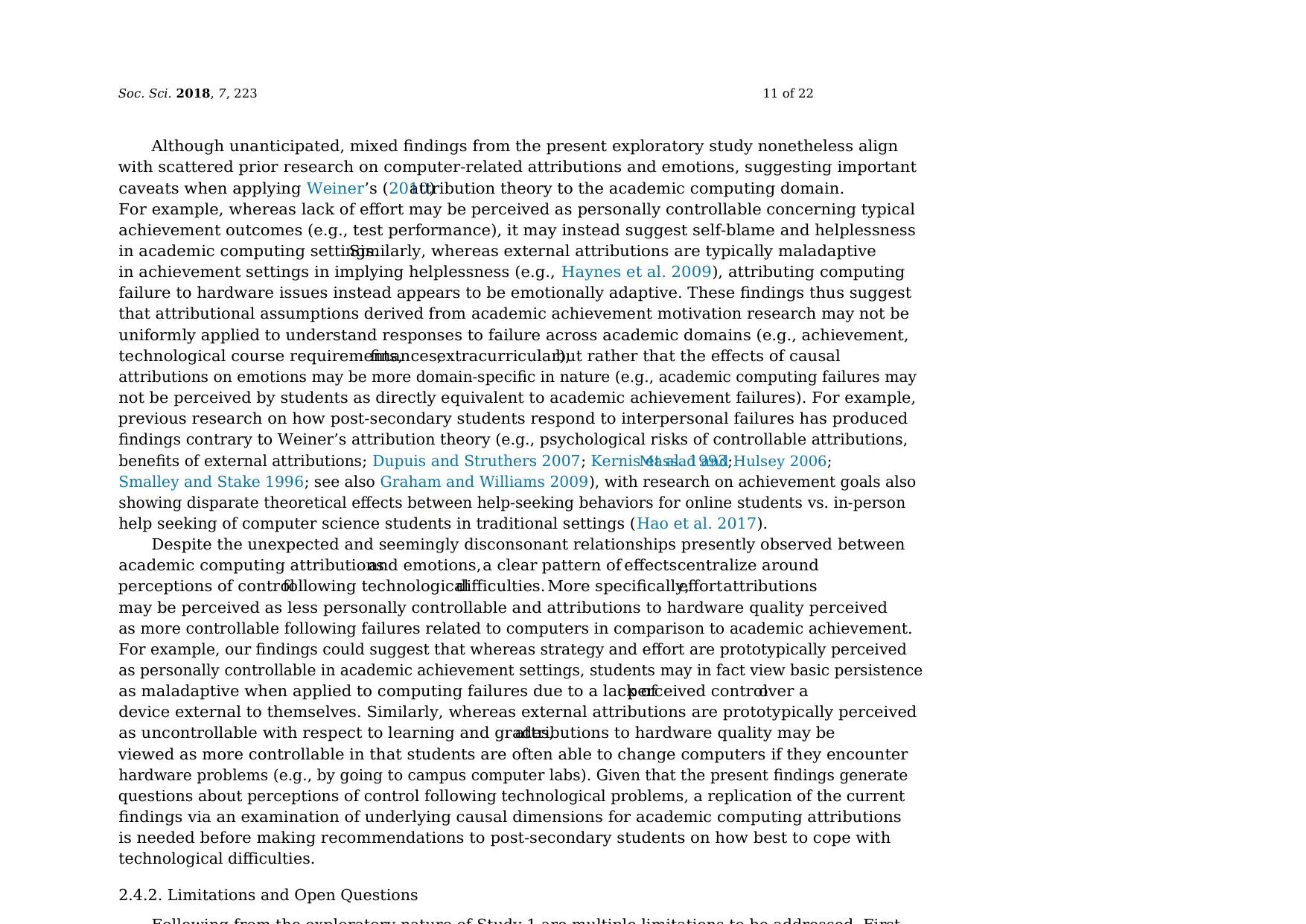
Soc. Sci. 2018, 7, 223 11 of 22
Although unanticipated, mixed findings from the present exploratory study nonetheless align
with scattered prior research on computer-related attributions and emotions, suggesting important
caveats when applying Weiner’s (2010)attribution theory to the academic computing domain.
For example, whereas lack of effort may be perceived as personally controllable concerning typical
achievement outcomes (e.g., test performance), it may instead suggest self-blame and helplessness
in academic computing settings.Similarly, whereas external attributions are typically maladaptive
in achievement settings in implying helplessness (e.g., Haynes et al. 2009), attributing computing
failure to hardware issues instead appears to be emotionally adaptive. These findings thus suggest
that attributional assumptions derived from academic achievement motivation research may not be
uniformly applied to understand responses to failure across academic domains (e.g., achievement,
technological course requirements,finances,extracurricular),but rather that the effects of causal
attributions on emotions may be more domain-specific in nature (e.g., academic computing failures may
not be perceived by students as directly equivalent to academic achievement failures). For example,
previous research on how post-secondary students respond to interpersonal failures has produced
findings contrary to Weiner’s attribution theory (e.g., psychological risks of controllable attributions,
benefits of external attributions; Dupuis and Struthers 2007; Kernis et al. 1993;Massad and Hulsey 2006;
Smalley and Stake 1996; see also Graham and Williams 2009), with research on achievement goals also
showing disparate theoretical effects between help-seeking behaviors for online students vs. in-person
help seeking of computer science students in traditional settings (Hao et al. 2017).
Despite the unexpected and seemingly disconsonant relationships presently observed between
academic computing attributionsand emotions,a clear pattern of effectscentralize around
perceptions of controlfollowing technologicaldifficulties. More specifically,effortattributions
may be perceived as less personally controllable and attributions to hardware quality perceived
as more controllable following failures related to computers in comparison to academic achievement.
For example, our findings could suggest that whereas strategy and effort are prototypically perceived
as personally controllable in academic achievement settings, students may in fact view basic persistence
as maladaptive when applied to computing failures due to a lack ofperceived controlover a
device external to themselves. Similarly, whereas external attributions are prototypically perceived
as uncontrollable with respect to learning and grades,attributions to hardware quality may be
viewed as more controllable in that students are often able to change computers if they encounter
hardware problems (e.g., by going to campus computer labs). Given that the present findings generate
questions about perceptions of control following technological problems, a replication of the current
findings via an examination of underlying causal dimensions for academic computing attributions
is needed before making recommendations to post-secondary students on how best to cope with
technological difficulties.
2.4.2. Limitations and Open Questions
Although unanticipated, mixed findings from the present exploratory study nonetheless align
with scattered prior research on computer-related attributions and emotions, suggesting important
caveats when applying Weiner’s (2010)attribution theory to the academic computing domain.
For example, whereas lack of effort may be perceived as personally controllable concerning typical
achievement outcomes (e.g., test performance), it may instead suggest self-blame and helplessness
in academic computing settings.Similarly, whereas external attributions are typically maladaptive
in achievement settings in implying helplessness (e.g., Haynes et al. 2009), attributing computing
failure to hardware issues instead appears to be emotionally adaptive. These findings thus suggest
that attributional assumptions derived from academic achievement motivation research may not be
uniformly applied to understand responses to failure across academic domains (e.g., achievement,
technological course requirements,finances,extracurricular),but rather that the effects of causal
attributions on emotions may be more domain-specific in nature (e.g., academic computing failures may
not be perceived by students as directly equivalent to academic achievement failures). For example,
previous research on how post-secondary students respond to interpersonal failures has produced
findings contrary to Weiner’s attribution theory (e.g., psychological risks of controllable attributions,
benefits of external attributions; Dupuis and Struthers 2007; Kernis et al. 1993;Massad and Hulsey 2006;
Smalley and Stake 1996; see also Graham and Williams 2009), with research on achievement goals also
showing disparate theoretical effects between help-seeking behaviors for online students vs. in-person
help seeking of computer science students in traditional settings (Hao et al. 2017).
Despite the unexpected and seemingly disconsonant relationships presently observed between
academic computing attributionsand emotions,a clear pattern of effectscentralize around
perceptions of controlfollowing technologicaldifficulties. More specifically,effortattributions
may be perceived as less personally controllable and attributions to hardware quality perceived
as more controllable following failures related to computers in comparison to academic achievement.
For example, our findings could suggest that whereas strategy and effort are prototypically perceived
as personally controllable in academic achievement settings, students may in fact view basic persistence
as maladaptive when applied to computing failures due to a lack ofperceived controlover a
device external to themselves. Similarly, whereas external attributions are prototypically perceived
as uncontrollable with respect to learning and grades,attributions to hardware quality may be
viewed as more controllable in that students are often able to change computers if they encounter
hardware problems (e.g., by going to campus computer labs). Given that the present findings generate
questions about perceptions of control following technological problems, a replication of the current
findings via an examination of underlying causal dimensions for academic computing attributions
is needed before making recommendations to post-secondary students on how best to cope with
technological difficulties.
2.4.2. Limitations and Open Questions
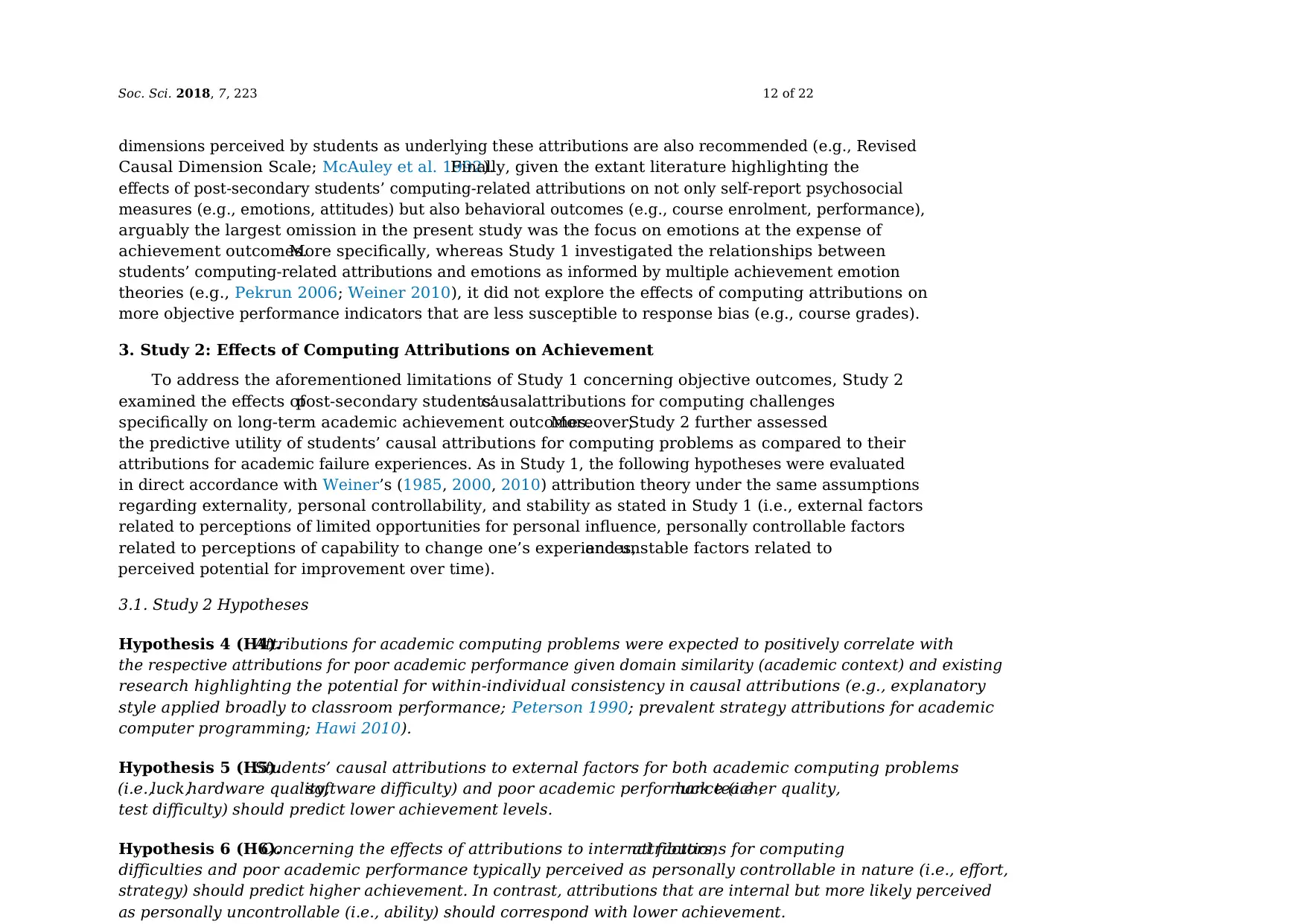
Soc. Sci. 2018, 7, 223 12 of 22
dimensions perceived by students as underlying these attributions are also recommended (e.g., Revised
Causal Dimension Scale; McAuley et al. 1992).Finally, given the extant literature highlighting the
effects of post-secondary students’ computing-related attributions on not only self-report psychosocial
measures (e.g., emotions, attitudes) but also behavioral outcomes (e.g., course enrolment, performance),
arguably the largest omission in the present study was the focus on emotions at the expense of
achievement outcomes.More specifically, whereas Study 1 investigated the relationships between
students’ computing-related attributions and emotions as informed by multiple achievement emotion
theories (e.g., Pekrun 2006; Weiner 2010), it did not explore the effects of computing attributions on
more objective performance indicators that are less susceptible to response bias (e.g., course grades).
3. Study 2: Effects of Computing Attributions on Achievement
To address the aforementioned limitations of Study 1 concerning objective outcomes, Study 2
examined the effects ofpost-secondary students’causalattributions for computing challenges
specifically on long-term academic achievement outcomes.Moreover,Study 2 further assessed
the predictive utility of students’ causal attributions for computing problems as compared to their
attributions for academic failure experiences. As in Study 1, the following hypotheses were evaluated
in direct accordance with Weiner’s (1985, 2000, 2010) attribution theory under the same assumptions
regarding externality, personal controllability, and stability as stated in Study 1 (i.e., external factors
related to perceptions of limited opportunities for personal influence, personally controllable factors
related to perceptions of capability to change one’s experiences,and unstable factors related to
perceived potential for improvement over time).
3.1. Study 2 Hypotheses
Hypothesis 4 (H4).Attributions for academic computing problems were expected to positively correlate with
the respective attributions for poor academic performance given domain similarity (academic context) and existing
research highlighting the potential for within-individual consistency in causal attributions (e.g., explanatory
style applied broadly to classroom performance; Peterson 1990; prevalent strategy attributions for academic
computer programming; Hawi 2010).
Hypothesis 5 (H5).Students’ causal attributions to external factors for both academic computing problems
(i.e.,luck,hardware quality,software difficulty) and poor academic performance (i.e.,luck teacher quality,
test difficulty) should predict lower achievement levels.
Hypothesis 6 (H6).Concerning the effects of attributions to internal factors,attributions for computing
difficulties and poor academic performance typically perceived as personally controllable in nature (i.e., effort,
strategy) should predict higher achievement. In contrast, attributions that are internal but more likely perceived
as personally uncontrollable (i.e., ability) should correspond with lower achievement.
dimensions perceived by students as underlying these attributions are also recommended (e.g., Revised
Causal Dimension Scale; McAuley et al. 1992).Finally, given the extant literature highlighting the
effects of post-secondary students’ computing-related attributions on not only self-report psychosocial
measures (e.g., emotions, attitudes) but also behavioral outcomes (e.g., course enrolment, performance),
arguably the largest omission in the present study was the focus on emotions at the expense of
achievement outcomes.More specifically, whereas Study 1 investigated the relationships between
students’ computing-related attributions and emotions as informed by multiple achievement emotion
theories (e.g., Pekrun 2006; Weiner 2010), it did not explore the effects of computing attributions on
more objective performance indicators that are less susceptible to response bias (e.g., course grades).
3. Study 2: Effects of Computing Attributions on Achievement
To address the aforementioned limitations of Study 1 concerning objective outcomes, Study 2
examined the effects ofpost-secondary students’causalattributions for computing challenges
specifically on long-term academic achievement outcomes.Moreover,Study 2 further assessed
the predictive utility of students’ causal attributions for computing problems as compared to their
attributions for academic failure experiences. As in Study 1, the following hypotheses were evaluated
in direct accordance with Weiner’s (1985, 2000, 2010) attribution theory under the same assumptions
regarding externality, personal controllability, and stability as stated in Study 1 (i.e., external factors
related to perceptions of limited opportunities for personal influence, personally controllable factors
related to perceptions of capability to change one’s experiences,and unstable factors related to
perceived potential for improvement over time).
3.1. Study 2 Hypotheses
Hypothesis 4 (H4).Attributions for academic computing problems were expected to positively correlate with
the respective attributions for poor academic performance given domain similarity (academic context) and existing
research highlighting the potential for within-individual consistency in causal attributions (e.g., explanatory
style applied broadly to classroom performance; Peterson 1990; prevalent strategy attributions for academic
computer programming; Hawi 2010).
Hypothesis 5 (H5).Students’ causal attributions to external factors for both academic computing problems
(i.e.,luck,hardware quality,software difficulty) and poor academic performance (i.e.,luck teacher quality,
test difficulty) should predict lower achievement levels.
Hypothesis 6 (H6).Concerning the effects of attributions to internal factors,attributions for computing
difficulties and poor academic performance typically perceived as personally controllable in nature (i.e., effort,
strategy) should predict higher achievement. In contrast, attributions that are internal but more likely perceived
as personally uncontrollable (i.e., ability) should correspond with lower achievement.
⊘ This is a preview!⊘
Do you want full access?
Subscribe today to unlock all pages.

Trusted by 1+ million students worldwide
1 out of 22
Related Documents
Your All-in-One AI-Powered Toolkit for Academic Success.
+13062052269
info@desklib.com
Available 24*7 on WhatsApp / Email
![[object Object]](/_next/static/media/star-bottom.7253800d.svg)
Unlock your academic potential
Copyright © 2020–2025 A2Z Services. All Rights Reserved. Developed and managed by ZUCOL.




